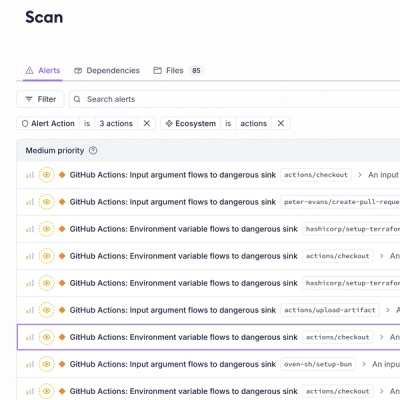
Product
Introducing Socket Firewall Enterprise: Flexible, Configurable Protection for Modern Package Ecosystems
Socket Firewall Enterprise is now available with flexible deployment, configurable policies, and expanded language support.
@ng-draw-flow/core
Advanced tools
A customizable Angular component for building node-based editors and interactive diagrams
NgDrawFlow is a library for creating interfaces based on displaying data as nodes. A node is a div container into which you can place any Angular component. The library takes care of all the state management of the node on the canvas. Thanks to this, it allows you to create both simple diagrams and complex editors for building customised charts and graphs.
taiga-family.github.io/ng-draw-flow
To get started locally you should have a few things:
First, spin up a new Angular project
ng new my-app
NgDrawFlow is published on npm as ng-draw-flow, so go ahead and add it next.
npm i @ng-draw-flow/core --save
Lastly, spin up the dev server and we're good to go!
ng serve
To get started with the ng-draw-flow library, begin by setting up your module with the necessary imports and component registrations.
Add the NgDrawFlowComponent and ReactiveFormsModule to your module's imports array:
imports: [
// ... (other necessary imports)
NgDrawFlowComponent,
ReactiveFormsModule,
];
Then, within the providers section, register the components that you want to be available for use as nodes within the graph editor and optionally configure connection arrowheads:
app.module.ts
providers: [
provideNgDrawFlowConfigs({
nodes: {
yourNode: YourNodeComponent,
},
connection: {
arrowhead: {type: DfArrowhead.Arrow},
},
}),
];
The connection.arrowhead option accepts a DfArrowhead value (Arrow, ArrowClosed, or None) and optional width
and height settings.
In the component where you intend to construct your graph, you need to create a data structure that defines the nodes and connections.
app.component.ts
data: DfDataModel = {
nodes: [],
connections: [],
};
form = new FormControl(this.data);
Next, link this data structure to your ng-draw-flow component using a FormControl. This will allow for reactive updates and interactions within your graph editor:
app.component.html
<ng-draw-flow [formControl]="form"></ng-draw-flow>
This setup ensures that your ng-draw-flow component is fully integrated with the Angular forms system, enabling seamless data flow and state management for your graph.
To illustrate how to set up the DfDataModel with actual data, the following example lays out a scenario with a
collection of nodes and their connections:
app.component.ts
data: DfDataModel = {
nodes: [
{
id: 'node-1',
data: {type: 'yourNode', text: 'This base node'},
position: {x: 0, y: 0},
startNode: true,
},
{id: 'node-2', data: {type: 'yourNode', text: 'This child node 1'}, position: {x: 250, y: 50}},
{id: 'node-3', data: {type: 'yourNode', text: 'This child node 2'}, position: {x: 250, y: -50}},
{
id: 'node-4',
data: {type: 'yourNode', text: 'This child node 3'},
position: {x: 500, y: 0},
endNode: true,
},
],
connections: [
{
source: {nodeId: 'node-1', connectorType: DfConnectionPoint.Output, connectorId: 'node-1-output-1'},
target: {nodeId: 'node-2', connectorType: DfConnectionPoint.Input, connectorId: 'node-2-input-1'},
},
{
source: {nodeId: 'node-1', connectorType: DfConnectionPoint.Output, connectorId: 'node-1-output-1'},
target: {nodeId: 'node-3', connectorType: DfConnectionPoint.Input, connectorId: 'node-3-input-1'},
},
{
source: {nodeId: 'node-2', connectorType: DfConnectionPoint.Output, connectorId: 'node-2-output-1'},
target: {nodeId: 'node-4', connectorType: DfConnectionPoint.Input, connectorId: 'node-4-input-1'},
},
{
source: {nodeId: 'node-3', connectorType: DfConnectionPoint.Output, connectorId: 'node-3-output-1'},
target: {nodeId: 'node-4', connectorType: DfConnectionPoint.Input, connectorId: 'node-4-input-1'},
},
],
};
Each node mainly consists of an id, a position, and a data field. Inside the data field, you need to specify
the node type that was previously registered and all the data you want to provide to the node.
The connections array contains objects that describe the start and end points of each connection. The source and
target holds information about which node and specific connector are used for each connection.
In ng-draw-flow, nodes can be customized to look and function just how you want them to. To create your own node, you
should develop a component that extends from the NgDrawFlowBaseNode class. This component will incorporate directives
such as DrawFlowInputDirective and DrawFlowOutputDirective.
import {NgIf} from '@angular/common';
import {ChangeDetectionStrategy, Component} from '@angular/core';
import {DfInputComponent, DfOutputComponent, DrawFlowBaseNode} from '@ng-draw-flow/core';
@Component({
standalone: true,
selector: 'app-your-node',
imports: [NgIf, DfInputComponent, DfOutputComponent],
templateUrl: './your-node.component.html',
styleUrls: ['./your-node.component.less'],
changeDetection: ChangeDetectionStrategy.OnPush,
})
export class YourNodeComponent extends DrawFlowBaseNode {}
:host {
background: var(--tui-base-09);
width: 10rem;
box-shadow: var(--tui-shadow);
border-radius: 0.5rem;
padding: 0.5rem;
border: 0.0625rem solid transparent;
transition: border-color 0.2s ease-in-out;
color: var(--tui-base-01);
&.df-selected {
border-color: var(--tui-text-action);
}
}
.input,
.output {
position: absolute;
z-index: 1;
}
.input {
left: -0.5rem;
top: 0.25rem;
}
.output-wrapper {
position: relative;
}
.output {
right: -0.5rem;
top: 0;
}
<df-input
class="input"
*ngIf="!startNode"
[connectorData]="{nodeId, connectorId: nodeId + '-input-1', single: false}"
/>
<p class="tui-text_body-xs">{{ model.text }}</p>
<df-output
class="output"
*ngIf="!endNode"
[connectorData]="{nodeId, connectorId: nodeId + '-output-1', single: false}"
/>
FAQs
A customizable Angular component for building node-based editors and interactive diagrams
The npm package @ng-draw-flow/core receives a total of 126 weekly downloads. As such, @ng-draw-flow/core popularity was classified as not popular.
We found that @ng-draw-flow/core demonstrated a healthy version release cadence and project activity because the last version was released less than a year ago. It has 4 open source maintainers collaborating on the project.
Did you know?

Socket for GitHub automatically highlights issues in each pull request and monitors the health of all your open source dependencies. Discover the contents of your packages and block harmful activity before you install or update your dependencies.

Product
Socket Firewall Enterprise is now available with flexible deployment, configurable policies, and expanded language support.

Security News
Open source dashboard CNAPulse tracks CVE Numbering Authorities’ publishing activity, highlighting trends and transparency across the CVE ecosystem.

Product
Detect malware, unsafe data flows, and license issues in GitHub Actions with Socket’s new workflow scanning support.